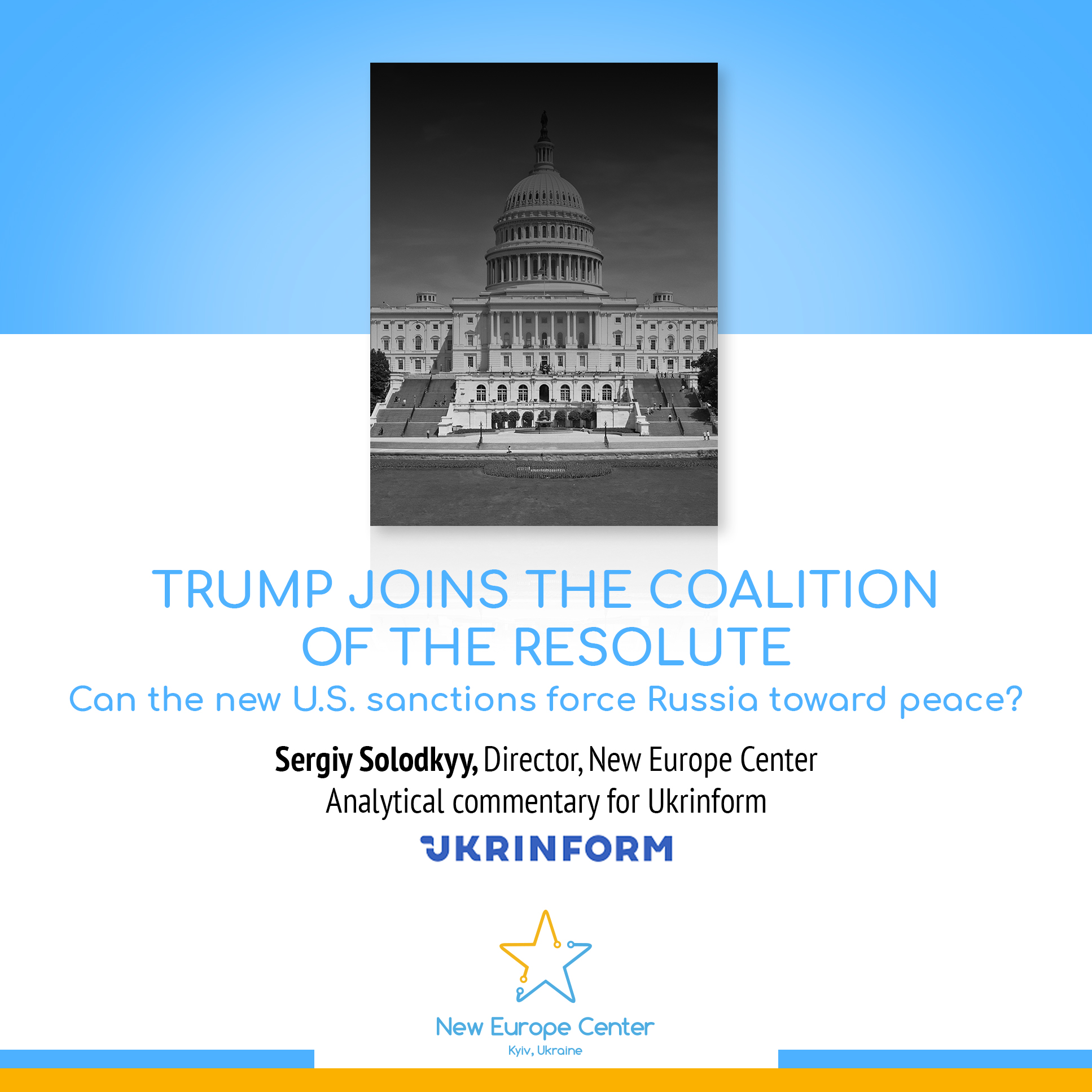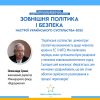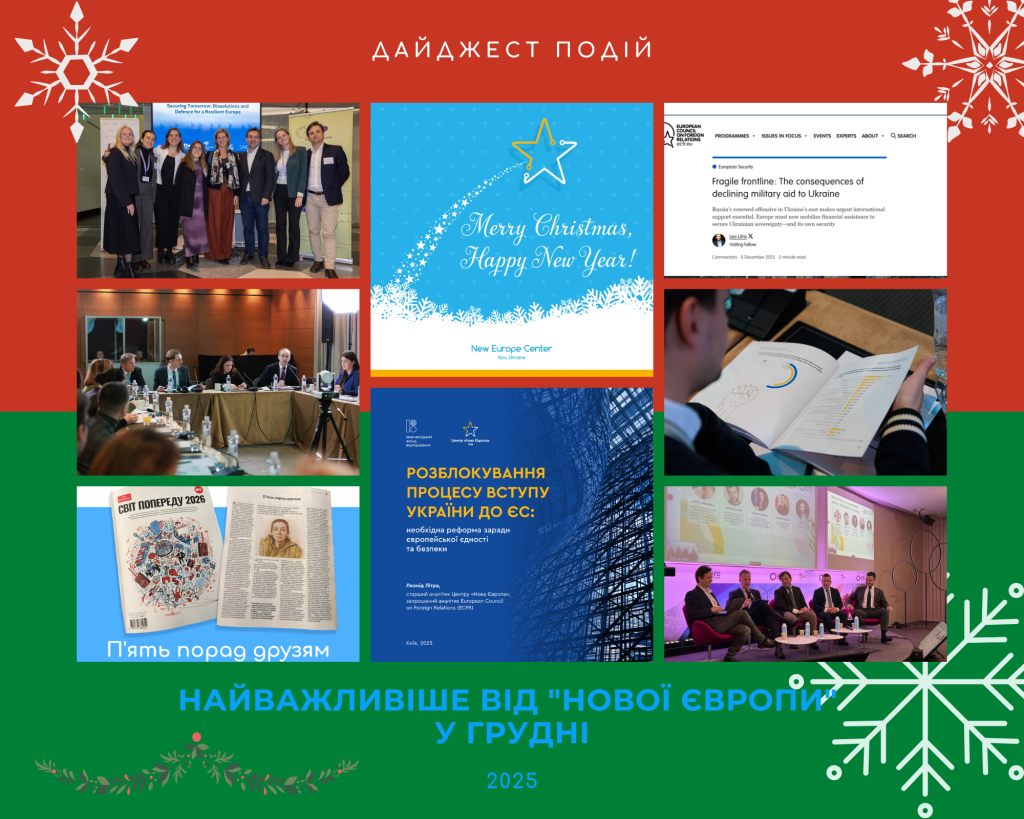
The commentary was kindly published by news agency Ukrinform.
Can new U.S. sanctions force Russia to make peace?
Can the new U.S. sanctions against Russia’s allies force Vladimir Putin to make peace? The effect will depend not on intentions but on the scale of action — Putin must see that the White House isn’t bluffing. Only then will Moscow be compelled to revise its war calculations.
Donald Trump has finally started moving in the right direction. He now has a chance to correct his past mistakes regarding Russia. A large-scale assistance package for Ukraine, combined with tough measures against Russia, could bring the prospect of real peace closer.
Initially, the U.S. threat to impose 100% tariffs on countries purchasing Russian energy sparked cautious reactions. Even in Ukraine — long a proponent of secondary sanctions — public commentary was marked by open pessimism: why wait 50 days? In Russia, this delayed potential punishment was perceived as an invitation to escalate aggression — a blank check to prolong the war.
Criticism of the delay is indeed valid. President Trump had previously set numerous deadlines for Russia, so the new timelines prompted resignation from some and smug satisfaction from others. Many observers doubted the impact of these sanctions, arguing that if Trump truly wanted to act, he would have done so long ago. It all gave the impression that when it came time for real action, the U.S. President would quietly let it slide — perhaps imposing watered-down sanctions only on companies directly purchasing Russian energy and lacking any interest in exporting to the U.S. market.
Trump became a hostage of his vague and sometimes chaotic foreign policy. On the Russia front, it wasn’t just chaotic — it was openly conciliatory, even flattering at times. He made some fundamental concessions to Moscow even before taking office — for example, criticizing Ukraine’s NATO membership prospects. Interruptions in arms and intelligence supplies to Ukraine, uncertainty about future military support, mocking statements aimed at the Ukrainian leadership, and repeated emphasis that “this is not my war” were enough for the Kremlin to conclude that the U.S. President wasn’t interested in Ukraine.
That Trump ultimately decided to change course reinforces his image as unpredictable and is forcing analysts to reassess the potential impact of the new sanctions. But this doesn’t mean the Kremlin will change its own approach — at least not until it’s convinced Trump isn’t bluffing.
Had President Trump demonstrated his resolve to punish Russia and its allies from the start of his term, today’s situation could have looked significantly different. That wouldn’t necessarily have deterred Moscow’s desire to dominate Ukraine entirely, but it would have made them act more cautiously — perhaps reverting to older hybrid tactics or even agreeing to a temporary truce, waiting for a more vulnerable moment in the West to strike harder later. Now, Trump must deliver a sanctions strike so forceful that no one will doubt America’s commitment to deterring Russian aggression.
In the early days of Trump’s presidency, the New Europe Center reached out to seasoned diplomats and analysts familiar with Russian negotiation tactics to ask: “What should the U.S. President take into consideration before the beginning of (and during) negotiations with Putin about Ukraine?” Reviewing that advice now helps explain why Trump effectively failed on the Russia track (at least to this point).
Most of those recommendations remain relevant today — and it appears Trump has had to learn them the hard way. Some key tips:
- 1. First negotiations – with partners. Before talking to Russia, the U.S. President must consult with Ukraine and key European partners.
- 2. Don’t count on a quick settlement. Trump should resist the temptation to see a short-term solution as a major victory.
- 3. Russia is weak. Despite Putin’s posturing, Russia enters negotiations from a severely weakened position, desperate to mitigate the catastrophic damage it inflicted upon itself.
- 4. Play the long game. Putin assumes time is on his side, but that advantage disappears if the West sustains support for Ukraine and increases pressure on Russia.
- 5. Implement the concept of “peace through strength.” To strengthen its leverage, the U.S. should commit to long-term military aid, coordinate with the G7 on reallocating frozen Russian assets, increase economic sanctions, and support Ukraine’s NATO membership.
Trump’s prolonged hesitations and decisions allowed Russia to believe it had completely neutralized the American factor in supporting Ukraine. His mistake was assuming Russia genuinely wanted peace and renewed cooperation with the West. But Trump’s latest moves have scrambled the deck (to borrow his own phrase). Now Moscow must guess what Washington’s next steps will be — whether regarding military support for Ukraine, coordination with Europe, or the scale of secondary sanctions. No matter what Russia’s allies do next, a 100% tariff will impact Russia’s military capacity. Even if China and India continue purchasing energy, they will force Moscow to compensate for the costs — possibly at prices far below market value, directly hurting Russia’s budget.
No matter how much Russia pretends not to care, no matter how loudly China threatens retaliation, or how much India tries to appear uninvolved, all three — Moscow, Beijing, and New Delhi — are holding their breath. The impact may be greater than it seems now. The first blow will target Russia’s budget, hitting civilian sectors hardest at first, but the indirect effects should be felt in the defense industry and on the battlefield. For instance, bonuses for “volunteers” may shrink significantly — and it may turn out that unpaid patriotism isn’t as widespread among Putin’s supporters as claimed.
But the main outcome could be a shift in perceptions of Trump. In Moscow, they can no longer rely on the assumption that the White House doesn’t care about Europe or Ukraine. For Putin, any partnership with Trump held no real value — Moscow likely assumed the U.S. president would eventually see through its thinly veiled game of pretending to seek peace. Russia didn’t want friendship with the U.S. — it wanted the U.S. to lose interest in Ukraine.
If Trump genuinely wants to change Russia’s behavior, he must “disappoint” Putin — by showing he’s ready to impose restrictive measures not only on Russia but also on its allies, and to provide sustained, large-scale support to Ukraine. Sanctions alone won’t suffice — it’s essential to back Ukraine’s military. After all, it wasn’t sanctions that stopped Putin, but Ukrainian soldiers.
If Trump dares to act boldly and comprehensively, he could be added to the list of countries in the “Coalition of the Willing” led by France and Britain. As we’ve seen, the “Coalition of the Willing,” despite some stumbles, has proven unexpectedly effective — even if the proposed deployment of troops hasn’t materialized, a series of diplomatic moves has helped restore Ukraine’s place on the U.S. agenda.
The key now is for U.S. actions not to be half-hearted. Trump’s decision to transfer Javelins to Ukraine back in the day was a strategically farsighted step. But his record also includes mistakes that emboldened the aggressor. The strength and scale of his next steps will determine the future course of events.
It’s also worth remembering: the Kremlin judges the U.S. President’s resolve based not only on 2025 actions. In January 2018, the U.S. published the so-called “Kremlin List,” naming 210 individuals close to Putin. The document was preceded by a major information campaign that shook Russia’s elite — it was expected to expose all the Kremlin-linked corruption. In the end, the published list was mockingly dubbed a “phone book” by Russians, as it contained no new information — everything was already publicly known. Now Trump has a historic chance to correct his past mistakes.







